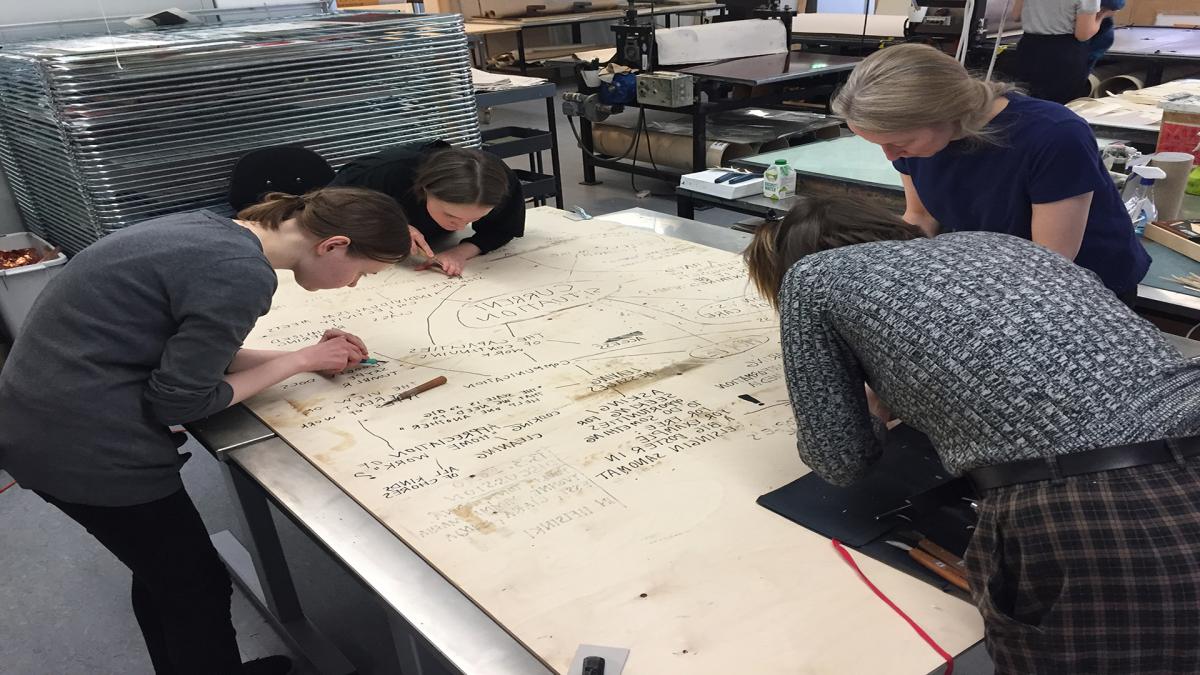Visiting Professor Ciara Phillips is fascinated by the communal dimension of printmaking
Ciara Phillips, Visiting Professor in Printmaking, has initiated workshops all around the world. According to Phillips, collaboration is a skill that can be practiced. Communality in person, which appears as an alternative for online interaction, plays an important role in her work.

Visiting Professor Ciara Phillips steps away from the computer screen for a moment.
The restrictions caused by the coronavirus pandemic have just come into force in Finland, and we are conducting the interview via Skype.
Soon Phillips returns holding a print made by students Sonja Donner and Johanna Heikkilä with the following text: “This scale is so big that we need to help one another.”
“We had a discussion with some students three weeks ago about the opening of our exhibition, There are already flowers. We had decided to make quite large-scale posters of the exhibition title as a starting point. One of the students remarked that “the scale is so big that we’re going to have to help each other.”
The Donner and Heikkilä then decided to adapt the phrase slightly and make it into prints using letterpress.
Since then, many things have changed: the exhibition has been cancelled, the doors of the Academy of Fine Arts are closed, and the world has largely come to a standstill.
And the phrase has a new resonance.
Phillips, who is of Canadian and Irish descent, supervised a course in printmaking at the Academy of Fine Arts called the Freedom of the Press. Like so many others, Phillips had to rethink the course plan because of the coronavirus.
Phillips’s teaching is largely based on communality and collaboration: how can we learn to function, work and make art together.
“Collaboration is a skill, and like all skills, you can become better at it through practice. Much of my work can be regarded as a counterbalance for online social interaction; it’s about getting people into a shared space and inviting them to work together. I think this is important, and I also gain a lot from the experience.”
Now, there is the additional challenge of how to teach collaboration and co-working skills when we should avoid all forms of physical interaction as much as we can.
“It’s about how we can continue to share ideas and plan ahead when everyone is confined to their homes,” says Phillips.
This is exactly what many of us are thinking about at the moment.
Phillips became interested in printmaking only after she had completed her university degrees in fine arts.
“It took me a while to realise that you can use the techniques employed in printmaking in non-traditional ways. My own practice started to become more experimental, and I began to focus more on the working process.”
Phillips became aware of the communal aspect of printmaking while working with students.
“The printmaking studio is a pretty collective environment, where people share can their ideas and skills with one another. I became interested in the democratic dimension of printmaking and its prior political and social applications.”
Corita Kent (1918–1986), an American printmaker and a nun, has been a major source of inspiration for Phillips’s artistic thinking. Kent’s art was often political in nature, and she used to apply communal working methods in her practice.
“She was quite the rebel,” says Phillips.
A good example of the political side of printmaking is feminist poster art produced by women’s art collectives and activist groups, such as the Guerrilla Girls and the See Red Women’s Workshop, a group that was active in the 1970s and the 1980s.
Phillips has initiated and lead workshops in printmaking both to art students and to activist groups all around the world. Screen printing is often used as a method in the workshops.
At the Academy of Fine Arts, Phillips has paid attention to a way of thinking which she has not encountered anywhere else.
“The materials used in printmaking and their ecological impact has been an important consideration for the students, and they are keenly aware of what kinds of materials they use. It’s really good that these things are being discussed.”
Traditionally, silk was used in the screen-printing process, but nowadays synthetic materials are almost exclusively used.
On the other hand, almost all materials and utensils that are used to produce art are in some way hazardous to the environment, says Phillips.
“The important thing is to figure out how we can keep working together on things that we are interested in – taking responsibility for our choices without grippling ourselves with guilt and stopping ourselves from being able to act as all.”
Silja Ylitalo